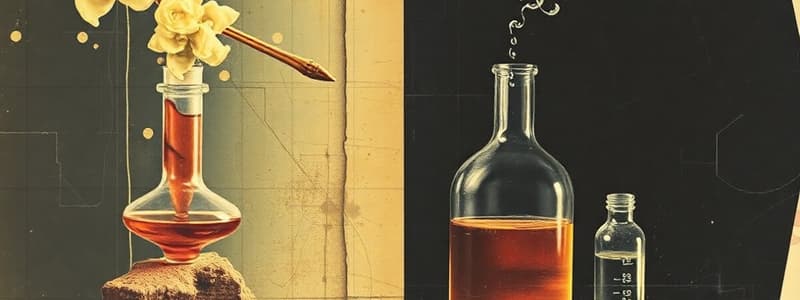Podcast
Questions and Answers
Given the general form of a chemical reaction $A + BC \rightarrow AC + B$, which type of reaction does this represent, and what key property of element A determines if the reaction will occur?
Given the general form of a chemical reaction $A + BC \rightarrow AC + B$, which type of reaction does this represent, and what key property of element A determines if the reaction will occur?
- Single displacement; the reactivity of A must be higher than that of B according to the activity series. (correct)
- Decomposition; the ionization energy of A must be lower than that of B.
- Single displacement; the electron affinity of A must be higher than that of C.
- Double displacement; the electronegativity of A must be significantly different than that of B.
A student performs a single replacement reaction experiment using Zinc (Zn) pieces, Copper (Cu) pieces, and solutions of $CuSO_4$ and $ZnSO_4$. After adding Zinc to $CuSO_4$ the student observes a color change. Adding Copper to $ZnSO_4$ yields no change. What conclusion can be drawn?
A student performs a single replacement reaction experiment using Zinc (Zn) pieces, Copper (Cu) pieces, and solutions of $CuSO_4$ and $ZnSO_4$. After adding Zinc to $CuSO_4$ the student observes a color change. Adding Copper to $ZnSO_4$ yields no change. What conclusion can be drawn?
- Zinc is more reactive than Copper because it displaced Copper from the sulfate solution. (correct)
- Both metals have equal reactivity, leading to neither metal displacing the other.
- The experiment was performed incorrectly; the reactivity of metals cannot be determined through single replacement reactions.
- Copper is more reactive than Zinc because the solution remained unchanged when Copper was added to Zinc Sulfate.
Consider five hypothetical elements: Q, W, X, Y, and Z. Given the following observations:
- Q reacts with the oxide of X but not with the oxide of W, Y, or Z.
- W reacts with the oxide of Y but not with the oxide of Z.
Rank the elements from most to least reactive.
Consider five hypothetical elements: Q, W, X, Y, and Z. Given the following observations:
- Q reacts with the oxide of X but not with the oxide of W, Y, or Z.
- W reacts with the oxide of Y but not with the oxide of Z.
Rank the elements from most to least reactive.
- Q > W > X > Y > Z
- Z > Y > W > Q > X
- Q > X > W > Y > Z (correct)
- Z > Y > W > X > Q
In a lab setting, a student mixes two solutions, expecting a double displacement reaction. However, upon mixing, no precipitate forms, no gas is evolved, and the temperature remains constant. What is the most likely explanation for this outcome?
In a lab setting, a student mixes two solutions, expecting a double displacement reaction. However, upon mixing, no precipitate forms, no gas is evolved, and the temperature remains constant. What is the most likely explanation for this outcome?
When balancing chemical equations, coefficients are used to ensure that the number of atoms of each element is the same on both sides of the equation. Which of the following correctly explains the fundamental principle behind this practice?
When balancing chemical equations, coefficients are used to ensure that the number of atoms of each element is the same on both sides of the equation. Which of the following correctly explains the fundamental principle behind this practice?
Flashcards
Combination/Synthesis Reaction
Combination/Synthesis Reaction
Two or more reactants combine to form a single product. (A + B → AB)
Decomposition Reaction
Decomposition Reaction
A single reactant breaks down into two or more products. (AB → A + B)
Single Displacement Reaction
Single Displacement Reaction
One element replaces another element in a compound. (A + BC → AC + B)
Activity Series
Activity Series
Signup and view all the flashcards
Single Displacement and Activity Series
Single Displacement and Activity Series
Signup and view all the flashcards
Study Notes
- There are five main types of chemical reactions: combination/synthesis, decomposition, single displacement, double displacement, and combustion.
Combination/Synthesis
- Two or more reactants combine to form a single product: A + B → AB.
- Iron (Fe) reacts with oxygen (O₂) to form iron oxide (Fe₂O₃): 4Fe(s) + 3O₂(g) → 2Fe₂O₃(s).
- Sodium (Na) reacts with chlorine (Cl₂) to form sodium chloride (NaCl): 2Na(s) + Cl₂(g) → 2NaCl(s).
Decomposition
- A single reactant breaks down into two or more products: AB → A + B.
- Silver oxide (Ag₂O) decomposes into silver (Ag) and oxygen (O₂): 2Ag₂O (s) → 4Ag (s) + O₂ (g).
- Ammonium nitrate (NH₄NO₃) decomposes into nitrous oxide (N₂O) and water (H₂O): NH₄NO₃(s) → N₂O(g) + 2H₂O(g).
Single Displacement
- One element replaces another element in a compound: A + BC → AC + B.
- An element that is more reactive will replace a less reactive element in a chemical reaction.
- Chlorine (Cl₂) reacts with potassium bromide (KBr) to form potassium chloride (KCl) and bromine (Br₂): Cl₂(aq) + 2KBr(aq) → 2KCl(aq) + Br₂(aq).
- An Activity Series ranks elements by their chemical reactivity
Double Displacement
- Two compounds exchange ions or bonds to form two different compounds: AB + CD → AD + CB.
- Lead(II) nitrate (Pb(NO₃)₂) reacts with potassium iodide (KI) to form lead(II) iodide (PbI₂) and potassium nitrate (KNO₃): Pb(NO₃)₂(aq) + 2KI(aq) → PbI₂(s) + 2KNO₃(aq).
- All double displacement reactions produce either a precipitate, a gas, or water.
- A precipitate is a solid formed as a result of a chemical reaction.
Combustion
- A rapid reaction between a substance with an oxidant, usually oxygen, to produce heat and light.
- Generally involves a hydrocarbon reacting with oxygen to produce carbon dioxide and water: Element/Compound + Oxygen → Oxide(s).
- Methane (CH₄) combusts with oxygen (O₂) to form carbon dioxide (CO₂) and water (H₂O): CH₄(g) + 2O₂(g) → CO₂(g) + 2H₂O(g).
- Acetylene (C₂H₂) combusts with oxygen (O₂) to form carbon dioxide (CO₂) and water (H₂O): 2C₂H₂(g) + 5O₂(g) → 4CO₂(g) + 2H₂O(g).
Single Replacement Reactions Lab Activity
- Main objective: Use single-replacement reactions to sequence metals into an activity series.
- Additional Objective: Design an experiment to determine relative reactivity.
- Materials for the lab include the metals Zinc (Zn), Copper (Cu), Lead (Pb), Magnesium (Mg), and Iron (Fe)
- Solutions required for this lab include: Pb(NO₃)₂, CuSO₄, MgSO₄, AgNO₃, and Fe(NO₃)₃.
- Data Collection: Create a data table with a specific title, labeled rows and columns, and clearly identifiable results for each combination of element and compound tested.
- Post-lab Analysis: Make an activity series in increasing order of reactivity for the metals and provide evidence to support your ranking of each metal
Activity Series
- Consider the following data for five hypothetical elements: Q, W, X, Y, and Z.
- Q + W⁺ → Reaction occurs
- X + Z⁺ → No reaction
- W + Z⁺ → Reaction occurs
- Q⁺ + Y → Reaction occurs
Studying That Suits You
Use AI to generate personalized quizzes and flashcards to suit your learning preferences.




